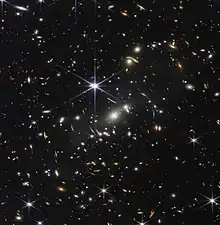CEERS-93316
CEERS-93316 هي مجرة مرشحة ذات انزياح أحمر عالي قُدر بنحو (z = 16.7) يعادل 235.8 مليون سنة بعد الانفجار العظيم، [7] [8] [9][10] وفي حالة تأكيدها ستكون من أقدم وأبعد المجرات المعروفة الملحوظة. [11] [3] [4] [12]
| CEERS-93316 | |
|---|---|
 Location of the CEERS-93316 galaxy is in the upper just right-of-center area of the العواء (كوكبة). | |
| الكوكبة | العواء (كوكبة)[1] |
| المكتشف | تلسكوب جيمس ويب الفضائي[2] |
| تاريخ الاكتشاف | 2022[2] |
| المطلع المستقيم | 14س 19د 39.48ث[1] |
| الميل | ° 52 ′56 ″34.92[1] |
| الانزياح الأحمر | 16.74+0.17 −0.31[1][3][4] |
| البعد |
|
| شاهد أيضًا: مجرة، قائمة المجرات | |
تبعد المجرة 13.5512 مليار سنة ضوئية، وبسبب تمدد الكون فإن المسافة المناسبة الحالية تبلغ 34.684 مليار سنة ضوئية. [5] [6] [13]
الاكتشاف

أبعد المجرات المرشحة وتاريخ الكون[14]
أنظر أيضا
مراجع
- Donnan, C.T.؛ وآخرون (25 يوليو 2022)، "The evolution of the galaxy UV luminosity function at redshifts z ~ 8-15 from deep JWST and ground-based near-infrared imaging - PAGE 9, TABLE 5" (PDF)، أرخايف، arXiv:2207.12356، مؤرشف من الأصل (PDF) في 4 أغسطس 2022، اطلع عليه بتاريخ 03 أغسطس 2022.
- معرف أرخايف: http://arxiv.org/abs/2207.12356
- Amos (26 يوليو 2022)، "Scottish astronomers push James Webb deeper back in time"، بي بي سي نيوز، مؤرشف من الأصل في 11 أغسطس 2022، اطلع عليه بتاريخ 04 أغسطس 2022.
- Tognetti (02 أغسطس 2022)، "The record for the farthest galaxy was just broken again, now just 250 million years after the Big Bang"، Universe Today، مؤرشف من الأصل في 10 أغسطس 2022، اطلع عليه بتاريخ 03 أغسطس 2022.
- Irving (03 أغسطس 2022)، "James Webb keeps breaking records for most distant galaxies ever seen"، New Atlas، مؤرشف من الأصل في 11 أغسطس 2022، اطلع عليه بتاريخ 04 أغسطس 2022.
- Staff (02 أغسطس 2022)، "James Webb Space Telescope helps identify most distant galaxy known"، News Nine، مؤرشف من الأصل في 1 أغسطس 2022، اطلع عليه بتاريخ 04 أغسطس 2022.
- Kempner, Joshua (2022)، "KEMPNER Cosmology Calculator"، Kempner.net، مؤرشف من الأصل في 05 أغسطس 2022، اطلع عليه بتاريخ 06 أغسطس 2022. KEMP Cosmology Calculator - Set H0=67.4 and OmegaM=0.315 (see Table/Planck2018 at "نموذج لامبدا-سي دي إم")
- Staff (01 أغسطس 2022)، "Edinburgh astronomers find most distant galaxy - Early data from a new space telescope has enabled Edinburgh astronomers to locate the most distant galaxy ever found."، جامعة إدنبرة، مؤرشف من الأصل في 9 أغسطس 2022، اطلع عليه بتاريخ 06 أغسطس 2022.
- Starr (05 أغسطس 2022)، "Astronomers Say They've Found The Most Distant Galaxy Ever Observed"، ScienceAlert، مؤرشف من الأصل في 11 أغسطس 2022، اطلع عليه بتاريخ 08 أغسطس 2022.
- Planck Collaboration (2020)، "Planck 2018 results. VI. Cosmological parameters"، Astronomy & Astrophysics، 641، page A6 (see PDF page 15, Table 2: "Age/Gyr", last column)، arXiv:1807.06209، Bibcode:2020A&A...641A...6P، doi:10.1051/0004-6361/201833910.
- Donnan, C.T.؛ وآخرون (25 يوليو 2022)، "The evolution of the galaxy UV luminosity function at redshifts z ~ 8-15 from deep JWST and ground-based near-infrared imaging" (PDF)، أرخايف، arXiv:2207.12356، مؤرشف من الأصل (PDF) في 4 أغسطس 2022، اطلع عليه بتاريخ 03 أغسطس 2022.
- Turner (01 أغسطس 2022)، "Webb space telescope has just imaged another most-distant galaxy, breaking its record after a week"، لايف ساينس (موقع)، مؤرشف من الأصل في 10 أغسطس 2022، اطلع عليه بتاريخ 03 أغسطس 2022.
- Kempner, Joshua (2022)، "KEMPNER Cosmology Calculator"، Kempner.net، مؤرشف من الأصل في 05 أغسطس 2022، اطلع عليه بتاريخ 06 أغسطس 2022.Kempner, Joshua (2022). "KEMPNER Cosmology Calculator". Kempner.net. Retrieved 6 August 2022. KEMP Cosmology Calculator - Set H0=67.4 and OmegaM=0.315 (see Table/Planck2018 at "نموذج لامبدا-سي دي إم")
- Lira؛ Iono؛ Oliver؛ Ferreira (07 أغسطس 2022)، "Astronomers Detect Most Distant Galaxy Candidate Yet - Updated by Dr. Dennis Bogdan"، مصفوف مرصد أتاكاما المليمتري الكبير، مؤرشف من الأصل في 17 يوليو 2022، اطلع عليه بتاريخ 07 أغسطس 2022.
روابط خارجية
- بوابة علم الفلك
- بوابة الكيمياء
- بوابة الفضاء
- بوابة الفيزياء
- بوابة نجوم
This article is issued from Wikipedia. The text is licensed under Creative Commons - Attribution - Sharealike. Additional terms may apply for the media files.

